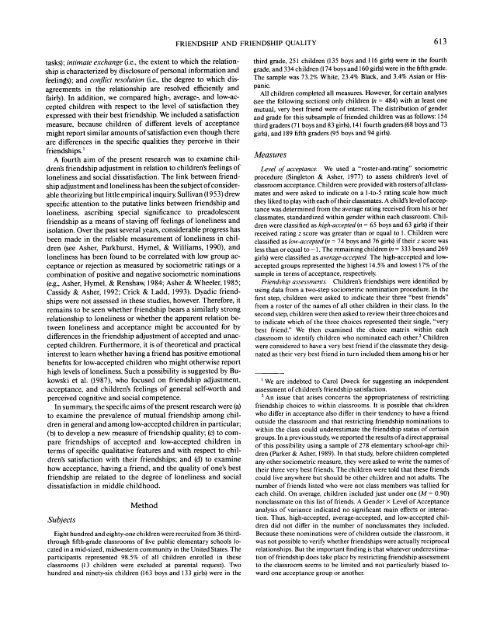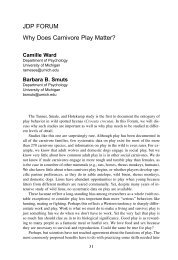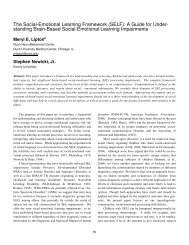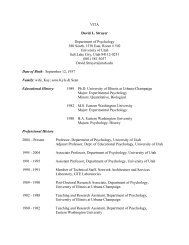Friendship and Friendship Quality in Middle Childhood ... - Psychology
Friendship and Friendship Quality in Middle Childhood ... - Psychology
Friendship and Friendship Quality in Middle Childhood ... - Psychology
Create successful ePaper yourself
Turn your PDF publications into a flip-book with our unique Google optimized e-Paper software.
FRIENDSHIP AND FRIENDSHIP QUALITY<br />
tasks); <strong>in</strong>timate exchange (i.e., the extent to which the relationship<br />
is characterized by disclosure of personal <strong>in</strong>formation <strong>and</strong><br />
feel<strong>in</strong>gs); <strong>and</strong> conflict resolution (i.e., the degree to which disagreements<br />
<strong>in</strong> the relationship are resolved efficiently <strong>and</strong><br />
fairly). In addition, we compared high-, average-, <strong>and</strong> low-accepted<br />
children with respect to the level of satisfaction they<br />
expressed with their best friendship. We <strong>in</strong>cluded a satisfaction<br />
measure, because children of different levels of acceptance<br />
might report similar amounts of satisfaction even though there<br />
are differences <strong>in</strong> the specific qualities they perceive <strong>in</strong> their<br />
friendships. 1<br />
A fourth aim of the present research was to exam<strong>in</strong>e children's<br />
friendship adjustment <strong>in</strong> relation to children's feel<strong>in</strong>gs of<br />
lonel<strong>in</strong>ess <strong>and</strong> social dissatisfaction. The l<strong>in</strong>k between friendship<br />
adjustment <strong>and</strong> lonel<strong>in</strong>ess has been the subject of considerable<br />
theoriz<strong>in</strong>g but little empirical <strong>in</strong>quiry. Sullivan (1953) drew<br />
specific attention to the putative l<strong>in</strong>ks between friendship <strong>and</strong><br />
lonel<strong>in</strong>ess, ascrib<strong>in</strong>g special significance to preadolescent<br />
friendship as a means of stav<strong>in</strong>g off feel<strong>in</strong>gs of lonel<strong>in</strong>ess <strong>and</strong><br />
isolation. Over the past several years, considerable progress has<br />
been made <strong>in</strong> the reliable measurement of lonel<strong>in</strong>ess <strong>in</strong> children<br />
(see Asher, Parkhurst, Hymel, & Williams, 1990), <strong>and</strong><br />
lonel<strong>in</strong>ess has been found to be correlated with low group acceptance<br />
or rejection as measured by sociometric rat<strong>in</strong>gs or a<br />
comb<strong>in</strong>ation of positive <strong>and</strong> negative sociometric nom<strong>in</strong>ations<br />
(e.g., Asher, Hymel, & Renshaw, 1984; Asher & Wheeler, 1985;<br />
Cassidy & Asher, 1992; Crick & Ladd, 1993). Dyadic friendships<br />
were not assessed <strong>in</strong> these studies, however. Therefore, it<br />
rema<strong>in</strong>s to be seen whether friendship bears a similarly strong<br />
relationship to lonel<strong>in</strong>ess or whether the apparent relation between<br />
lonel<strong>in</strong>ess <strong>and</strong> acceptance might be accounted for by<br />
differences <strong>in</strong> the friendship adjustment of accepted <strong>and</strong> unaccepted<br />
children. Furthermore, it is of theoretical <strong>and</strong> practical<br />
<strong>in</strong>terest to learn whether hav<strong>in</strong>g a friend has positive emotional<br />
benefits for low-accepted children who might otherwise report<br />
high levels of lonel<strong>in</strong>ess. Such a possibility is suggested by Bukowski<br />
et al. (1987), who focused on friendship adjustment,<br />
acceptance, <strong>and</strong> children's feel<strong>in</strong>gs of general self-worth <strong>and</strong><br />
perceived cognitive <strong>and</strong> social competence.<br />
In summary, the specific aims of the present research were (a)<br />
to exam<strong>in</strong>e the prevalence of mutual friendship among children<br />
<strong>in</strong> general <strong>and</strong> among low-accepted children <strong>in</strong> particular;<br />
(b) to develop a new measure of friendship quality; (c) to compare<br />
friendships of accepted <strong>and</strong> low-accepted children <strong>in</strong><br />
terms of specific qualitative features <strong>and</strong> with respect to children's<br />
satisfaction with their friendships; <strong>and</strong> (d) to exam<strong>in</strong>e<br />
how acceptance, hav<strong>in</strong>g a friend, <strong>and</strong> the quality of one's best<br />
friendship are related to the degree of lonel<strong>in</strong>ess <strong>and</strong> social<br />
dissatisfaction <strong>in</strong> middle childhood.<br />
Subjects<br />
Method<br />
Eight hundred <strong>and</strong> eighty-one children were recruited from 36 thirdthrough<br />
fifth-grade classrooms of five public elementary schools located<br />
<strong>in</strong> a mid-sized, midwestern community <strong>in</strong> the United States. The<br />
participants represented 98.5% of all children enrolled <strong>in</strong> these<br />
classrooms (13 children were excluded at parental request). Two<br />
hundred <strong>and</strong> n<strong>in</strong>ety-six children (163 boys <strong>and</strong> 133 girls) were <strong>in</strong> the<br />
613<br />
third grade, 251 children (135 boys <strong>and</strong> 116 girls) were <strong>in</strong> the fourth<br />
grade, <strong>and</strong> 334 children (174 boys <strong>and</strong> 160 girls) were <strong>in</strong> the fifth grade.<br />
The sample was 73.2% White, 23.4% Black, <strong>and</strong> 3.4% Asian or Hispanic.<br />
All children completed all measures. However, for certa<strong>in</strong> analyses<br />
(see the follow<strong>in</strong>g sections) only children (« = 484) with at least one<br />
mutual, very best friend were of <strong>in</strong>terest. The distribution of gender<br />
<strong>and</strong> grade for this subsample of friended children was as follows: 154<br />
third graders (71 boys <strong>and</strong> 83 girls), 141 fourth graders (68 boys <strong>and</strong> 73<br />
girls), <strong>and</strong> 189 fifth graders (95 boys <strong>and</strong> 94 girls).<br />
Measures<br />
Level of acceptance. We used a "roster-<strong>and</strong>-rat<strong>in</strong>g" sociometric<br />
procedure (S<strong>in</strong>gleton & Asher, 1977) to assess children's level of<br />
classroom acceptance. Children were provided with rosters of all classmates<br />
<strong>and</strong> were asked to <strong>in</strong>dicate on a l-to-5 rat<strong>in</strong>g scale how much<br />
they liked to play with each of their classmates. A child's level of acceptance<br />
was determ<strong>in</strong>ed from the average rat<strong>in</strong>g received from his or her<br />
classmates, st<strong>and</strong>ardized with<strong>in</strong> gender with<strong>in</strong> each classroom. Children<br />
were classified as high-accepted (n = 65 boys <strong>and</strong> 63 girls) if their<br />
received rat<strong>in</strong>g z score was greater than or equal to 1. Children were<br />
classified as low-accepted (n = 74 boys <strong>and</strong> 76 girls) if their z score was<br />
less than or equal to -1. The rema<strong>in</strong><strong>in</strong>g children (n = 333 boys <strong>and</strong> 269<br />
girls) were classified as average-accepted. The high-accepted <strong>and</strong> lowaccepted<br />
groups represented the highest 14.5% <strong>and</strong> lowest 17% of the<br />
sample <strong>in</strong> terms of acceptance, respectively.<br />
<strong>Friendship</strong> assessments. Children's friendships were identified by<br />
us<strong>in</strong>g data from a two-step sociometric nom<strong>in</strong>ation procedure. In the<br />
first step, children were asked to <strong>in</strong>dicate their three "best friends"<br />
from a roster of the names of all other children <strong>in</strong> their class. In the<br />
second step, children were then asked to review their three choices <strong>and</strong><br />
to <strong>in</strong>dicate which of the three choices represented their s<strong>in</strong>gle, "very<br />
best friend." We then exam<strong>in</strong>ed the choice matrix with<strong>in</strong> each<br />
classroom to identify children who nom<strong>in</strong>ated each other. 2 Children<br />
were considered to have a very best friend if the classmate they designated<br />
as their very best friend <strong>in</strong> turn <strong>in</strong>cluded them among his or her<br />
' We are <strong>in</strong>debted to Carol Dweck for suggest<strong>in</strong>g an <strong>in</strong>dependent<br />
assessment of children's friendship satisfaction.<br />
2 An issue that arises concerns the appropriateness of restrict<strong>in</strong>g<br />
friendship choices to with<strong>in</strong> classrooms. It is possible that children<br />
who differ <strong>in</strong> acceptance also differ <strong>in</strong> their tendency to have a friend<br />
outside the classroom <strong>and</strong> that restrict<strong>in</strong>g friendship nom<strong>in</strong>ations to<br />
with<strong>in</strong> the class could underestimate the friendship status of certa<strong>in</strong><br />
groups. In a previous study, we reported the results of a direct appraisal<br />
of this possibility us<strong>in</strong>g a sample of 278 elementary school-age children<br />
(Parker & Asher, 1989). In that study, before children completed<br />
any other sociometric measure, they were asked to write the names of<br />
their three very best friends. The children were told that these friends<br />
could live anywhere but should be other children <strong>and</strong> not adults. The<br />
number of friends listed who were not class members was tallied for<br />
each child. On average, children <strong>in</strong>cluded just under one (M = 0.90)<br />
nonclassmate on this list of friends. A Gender X Level of Acceptance<br />
analysis of variance <strong>in</strong>dicated no significant ma<strong>in</strong> effects or <strong>in</strong>teraction.<br />
Thus, high-accepted, average-accepted, <strong>and</strong> low-accepted children<br />
did not differ <strong>in</strong> the number of nonclassmates they <strong>in</strong>cluded.<br />
Because these nom<strong>in</strong>ations were of children outside the classroom, it<br />
was not possible to verify whether friendships were actually reciprocal<br />
relationships. But the important f<strong>in</strong>d<strong>in</strong>g is that whatever underestimation<br />
of friendship does take place by restrict<strong>in</strong>g friendship assessment<br />
to the classroom seems to be limited <strong>and</strong> not particularly biased toward<br />
one acceptance group or another.





